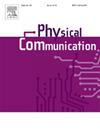基于线性接收机的大型智能曲面上行链路遍历容量估计
IF 2.2
4区 计算机科学
Q3 ENGINEERING, ELECTRICAL & ELECTRONIC
引用次数: 0
摘要
在本文中,我们研究了具有大量活动元素的大型智能表面(LIS)系统中数据传输的潜力。这一新兴概念有望超越目前大规模MIMO技术的性能范围。在LIS系统中,近场传输特性起着重要的作用。我们在期望信道为完美瞄准线(LoS)的假设下分析了信道容量,而干扰信道表现为空间相关的衰落。考虑了最大比值组合(MRC)、零强迫(ZF)和最小均方误差(MMSE)组合方案。对基于lis系统的上行链路遍历容量进行了近似分析,得到了一个上界,与仿真结果吻合较好。我们的研究结果表明,该系统中的信道有利于传播,在这些条件下实现更高的容量。本文章由计算机程序翻译,如有差异,请以英文原文为准。
Ergodic capacity estimation in the uplink of large intelligent surfaces with linear receivers
In this paper, we investigate the potential of data transmission in a large intelligent surface (LIS) system with a massive number of active elements. This emerging concept promises performance that surpasses the current scope of massive MIMO technology. In a LIS system, near-field propagation properties play a significant role. We analyze the channel capacity under the assumption that the desired channel is a perfect line of sight (LoS), while interference channels exhibit spatially correlated Rician fading. maximum ratio combining (MRC), zero forcing (ZF), and minimum mean square error (MMSE) combining schemes are considered. An approximate analysis of the uplink ergodic capacity in a LIS-based system is conducted, and an upper bound is derived, aligning well with simulation results. Our findings demonstrate that the channel in this system favorable propagation, enabling higher capacity under these conditions.
求助全文
通过发布文献求助,成功后即可免费获取论文全文。
去求助
来源期刊

Physical Communication
ENGINEERING, ELECTRICAL & ELECTRONICTELECO-TELECOMMUNICATIONS
CiteScore
5.00
自引率
9.10%
发文量
212
审稿时长
55 days
期刊介绍:
PHYCOM: Physical Communication is an international and archival journal providing complete coverage of all topics of interest to those involved in all aspects of physical layer communications. Theoretical research contributions presenting new techniques, concepts or analyses, applied contributions reporting on experiences and experiments, and tutorials are published.
Topics of interest include but are not limited to:
Physical layer issues of Wireless Local Area Networks, WiMAX, Wireless Mesh Networks, Sensor and Ad Hoc Networks, PCS Systems; Radio access protocols and algorithms for the physical layer; Spread Spectrum Communications; Channel Modeling; Detection and Estimation; Modulation and Coding; Multiplexing and Carrier Techniques; Broadband Wireless Communications; Wireless Personal Communications; Multi-user Detection; Signal Separation and Interference rejection: Multimedia Communications over Wireless; DSP Applications to Wireless Systems; Experimental and Prototype Results; Multiple Access Techniques; Space-time Processing; Synchronization Techniques; Error Control Techniques; Cryptography; Software Radios; Tracking; Resource Allocation and Inference Management; Multi-rate and Multi-carrier Communications; Cross layer Design and Optimization; Propagation and Channel Characterization; OFDM Systems; MIMO Systems; Ultra-Wideband Communications; Cognitive Radio System Architectures; Platforms and Hardware Implementations for the Support of Cognitive, Radio Systems; Cognitive Radio Resource Management and Dynamic Spectrum Sharing.
 求助内容:
求助内容: 应助结果提醒方式:
应助结果提醒方式:


